In this guide, we’ll walk you through how to customize the password protected page in WordPress using a couple of different methods, including:
- Customizing using default settings.
- Customizing using the password protect WordPress plugin, Passster.

But first, let’s understand why it’s important to customize the default password-protected page in WordPress.
Table of Contents
Why customize the default password-protected page in WordPress?
The default password-protected page in WordPress does the job if you need something very simple in design and security.
But it could be upgraded to improve security and offer more control and flexibility in designing the password protection form.
Below we’ll go through these points in a little more detail.
The default WordPress password-protected page design could be improved
The default WordPress password-protected page is quite basic. It only comprises a form with the message “This content is password protected. To view it, please enter your password below:” and a password input field.
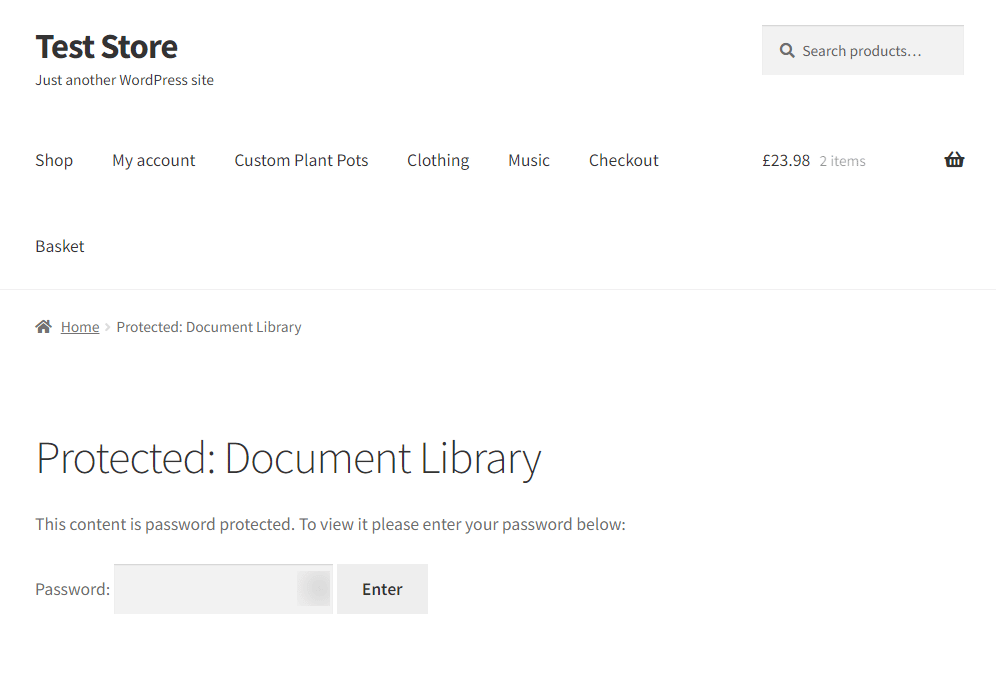
Its design is completely dependent on your active WordPress theme or template. The basic design of the standard password-protect form may not work for your business if:
- You want to provide a custom message on the password-protect form. You might want to add a message to specify who this content is limited to and why. For example, if it’s an employees-only page, customers will understand if they stumble on this page and are met with a custom message indicating that the page is to be accessed only by employees. The content could also be for members as a login form, or for content that’s yet to be released to the public.
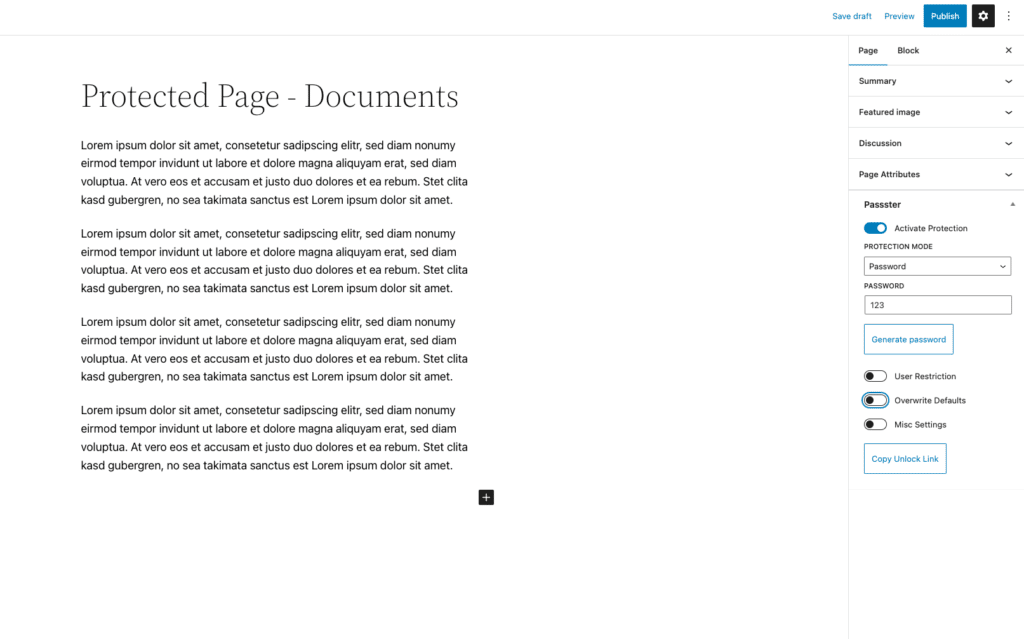
- You want to add a redirection link to allow users to go back to the homepage or to the content they are allowed to access. So they don’t get stuck on the password-protected/login page.
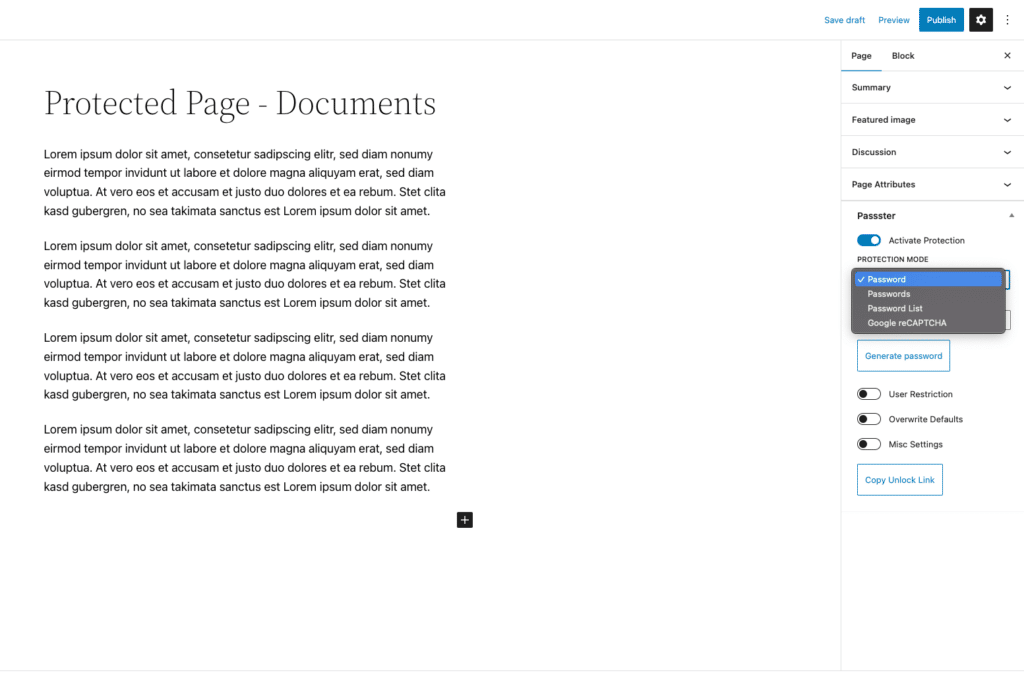
- You want to add more widgets to capture leads. For example, if you want site visitors to sign up for memberships so that they can receive the password to access exclusive content or pages. You’ll need to have sign-up buttons. This also applies if you want to add social sharing icons.
The default password-protected page in WordPress is extremely hard to customize. As a result, you might end up stuck with the default option, which we don’t want.
The default password protect form doesn’t give you a lot of options
The default WordPress password form only gives you a single option to protect your pages. Just one password per page, and that’s it.
This method is not as secure as it should be, nor does it give you much flexibility. Since you’re only using a single password for your pages, suppose an unauthorized person stumbles on the password. That’s all they’ll need to breach your security. Besides, if a user has access to your WordPress backend, they can easily change the password and lock you out of your own pages.
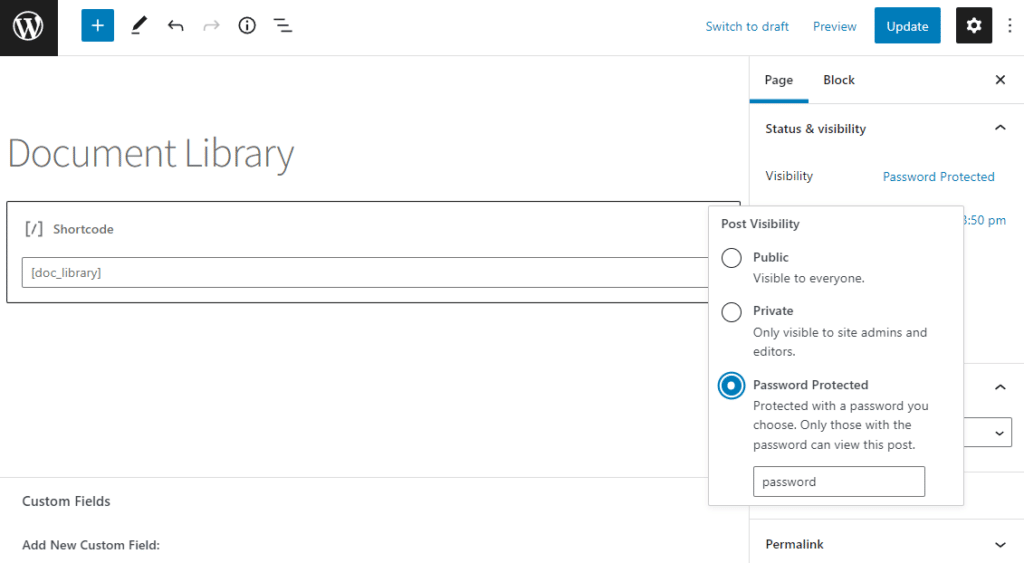
The default WordPress password protection form is very limited. This is because:
You can’t choose what to protect on your WordPress site
WordPress’s default password protection feature only allows you to protect a single page. So if you want to protect your whole site or just sections of a page, you can’t.
You can’t choose how to protect your content
Apart from the single password per page, the default WordPress password protection form doesn’t offer additional options for protecting your site’s content.
So, you can’t use things like CAPTCHA/reCAPTCHA, expiring passwords, multiple passwords, and so on. You’re stuck with that single password per page.
You can’t improve your users’ experience with passwords
It doesn’t allow you to implement web cookies so that users can automatically unlock protected content with the same password.
So now we know why you might want to customize the password protected page in WordPress. Let’s put it into action. Starting with a tutorial on customizing the default page with some built-in WordPress options.
How to Customize the Password Protected Page in WordPress
Although the default password-protect form falls short, there are a few settings you can change to get the best out of it. In terms of security, there isn’t more you can do, but you can improve the design to look better.
Customize the password-protected page using default settings
While this is basic, you can customize the default password-protect form to look slightly better using these simple steps.
How to create your password-protected page
- Go to the WordPress dashboard and open the page or post you want to protect.
- In the publish meta box, there’s a visibility option. Click on it and then choose the password-protected option in the dropdown menu.
- Enter the password you want your users to enter when they access the content.

- Click Publish to save changes.
How to customize your password-protected page
Once you have a password-protected page, you can proceed to view it in the front end and then click Customize in the top bar to open the WordPress Customizer.
Here, you can customize many elements of your WordPress site’s design. This includes adjusting the margins, page layouts, and padding around your password-protect form to have it look better.
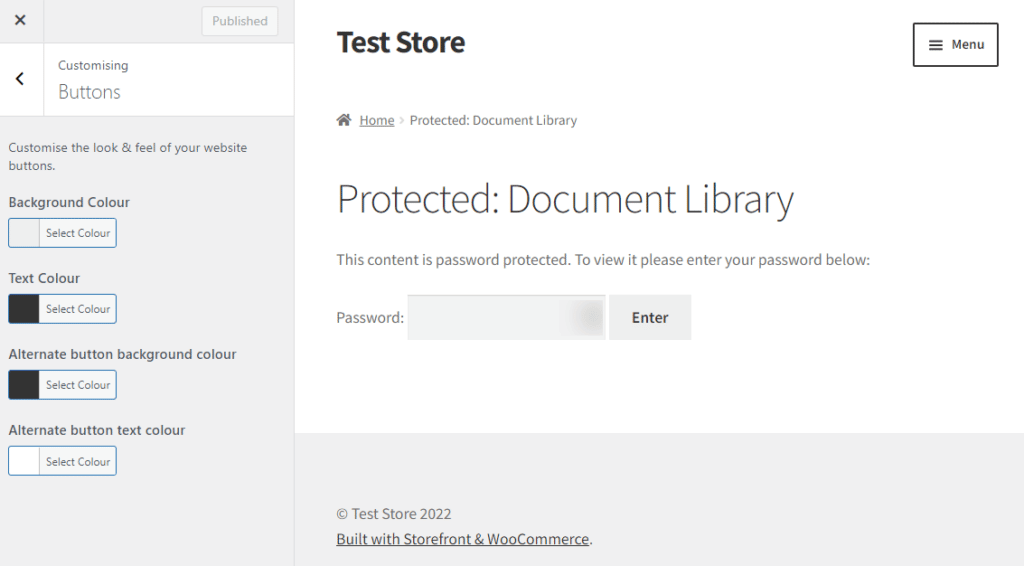
Remember that many changes in the default settings will affect your whole WordPress site. For example, if you change the design of the buttons (including the form submit button), this will change the style of buttons across the whole site. You can also change fonts here, which will be applied across your site.
If you want to customize the password protect form without affecting the rest of your site’s design while having more control over the design and options for this form, you’ll need the help of a plugin.
Customize using the password protect WordPress plugin, Passster
Passster is a secure password protection plugin for WordPress. It enables you to reinforce the security of your password-protected content or site while giving you the tools to upgrade the design of your password protection form.
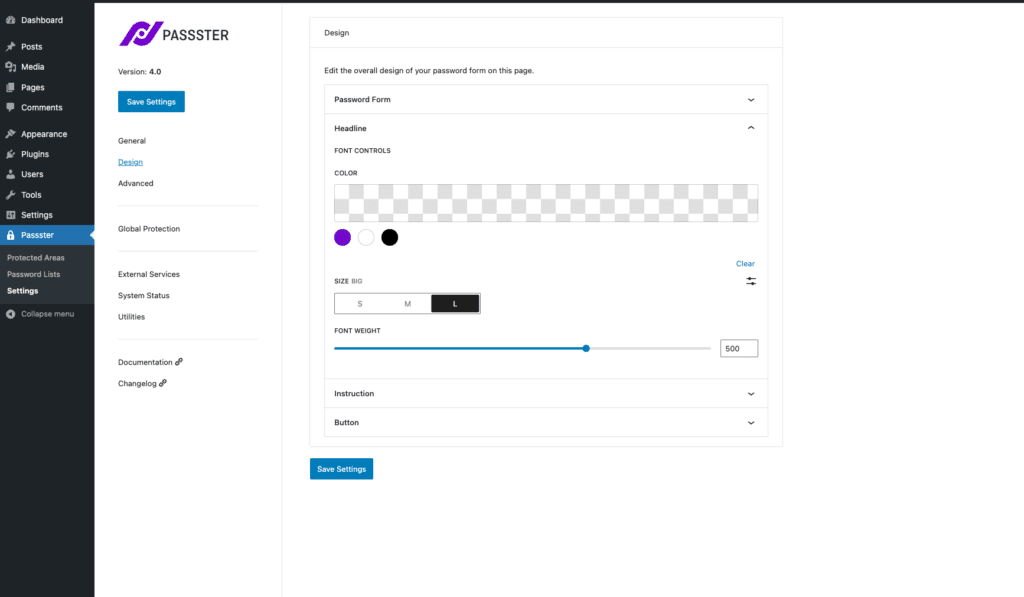
It provides you with the tools to effortlessly add layers of security to your WordPress site, no matter the post type. Single posts, pages, or your entire WordPress site can be protected, all while giving your password protection forms their best look possible.
With Passster, you can customize your password-protected page in WordPress by doing the following:
- Give your form a personal touch by editing its headline, instructions, and placeholder text.
- Edit the general look and feel of this form/page/protected post by changing the background color, padding, margins, and so on, just like you would for a normal page or form.
- Edit the text’s style by changing the font family, style, weight, etc.
- Edit the submit button’s style, including the text and what happens to it on hover.
Passster
Protect your entire website, entire pages, or just parts of your content with one or more passwords.
Passster’s password protection form seamlessly integrates with your page builder (like Divi or Elementor), and you’ll be able to do all the above using your page builder’s page template too.
Passster not only lets you upgrade your form’s design, but you also get to beef up your password-protected page’s security in the following ways:
- Select your password protection type – such as single password, multiple passwords, password list, encrypted links, and reCAPTCHA.
- Expire passwords by usage and date to minimize the effects of password leakage.
- Track concurrent logins to prevent unauthorized password sharing.

You can also use web cookies to improve user experience with passwords so that users can automatically unlock protected content with the same password.
Knowing what Passster brings to the table, let’s get it set up in your store.
Step 1: Add Passster to your WordPress website
First, you’ll need to purchase the Pro version of Passster: patrickposner.dev/plugins/passster and download the WordPress plugin to your computer.
Passster
Protect your entire website, entire pages, or just parts of your content with one or more passwords.
Then, follow these steps to install Passster:
- Go to Plugins > Add New > Upload plugin from your WordPress dashboard.
- Upload the extension you downloaded and click Install Now.
- After installation is complete, click Activate Plugin. Copy your license key from your email and click on Agree and Activate Plugin.
Now that Passster has been added to your WordPress site, we can proceed to select the content we want to protect.
Step 2: Select the content you want to protect
For this guide, we’ll show you how to protect a page or post and select the type of protection you wish to apply. To do this, follow the steps below.
- Navigate to Pages > All pages from your WordPress dashboard and click to edit the page you want to protect.
- A settings sidebar will appear on your right-hand side. Scroll down until you locate the Passster page protection section.
- Next, click to toggle the Activate Protection switch to protect your page.
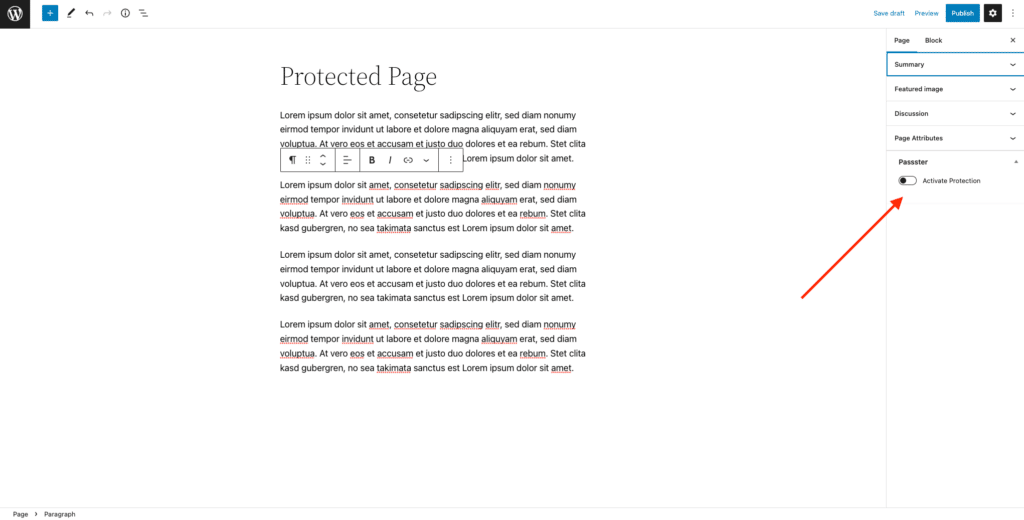
- Now, select the protection type in the Protection Type dropdown menu. You’ll have six protection options; password, passwords, password list and reCAPTCHA. For the purposes of this guide, we’ll set a unique password to protect our WordPress page.

- Set a redirection URL in the Redirection field once you’ve selected your preferred protection type. This will direct your visitors to another URL when logged in to your website.
- Below this, you can restrict access to a specific user role, or username under the User Restriction field.
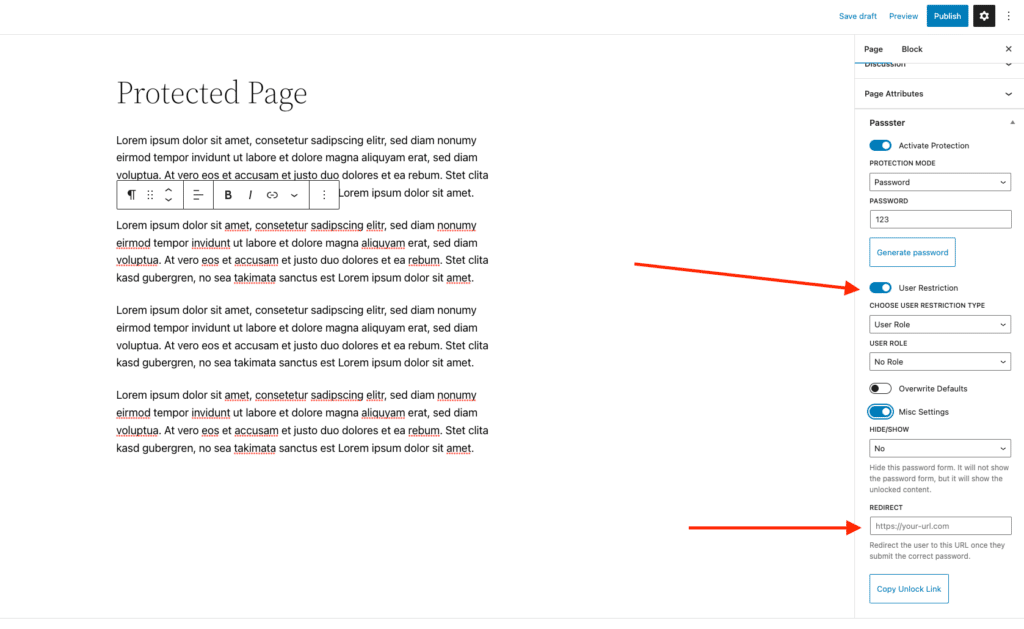
- You’ll have a few options to customize texts on your protected page: the headline, instruction, placeholder, button, and form elements.
- Finally, click the blue Publish button at the top of the page, to protect your page.
Now your page is protected, we can customize the design of your password-protected form.
Step 3: Customize the password-protected form
Customizing Passster’s protected form is straightforward. Unlike the default WordPress settings, the changes you make on this form will not be applied across your store. They will be confined to the password protection form.
To customize your protection follow these steps:
- Go to Passster > Settings->Design from your WordPress dashboard.
- Change colors, font sizes, border radius, and more
- Switch to Passster-Settings-General if you like to overwrite things like the headline, instruction(…)

- Once you’re satisfied with your changes, click Save Settings. You can now exit this page, and that’s it. You’re done.
That’s it. You’ve now used Passster to improve your password-protected page’s security and the design of the password-protected forms.
Customize your password-protected WordPress page today
The default WordPress password-protected page is limited in security and the form’s design. It doesn’t allow you to add more protection features to strengthen its security, nor does it give you flexibility and control over how you design the password protection forms.
With the help of the WordPress plugin Passster, you will get full control and flexibility over how you design the password-protected form. You will also be able to choose what to protect and how to protect it.
Passster
Protect your entire website, entire pages, or just parts of your content with one or more passwords.